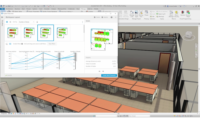Faith in the quality of structural-steel building-information-model file transfers between different BIM platforms increased recently, thanks to a series of digital-data-exchange validation tests performed under the auspices of the American Institute of Steel Construction. The news is good: Each of the six transfers studied was extremely accurate. Some even had as little as 0.3% error, which matches human error, say researchers.
"We have established a trust and comfort level with the [data exchange] process," said Brian Cobb, chief operating officer of Structural Detailing LLC (SDLLC), Brentwood, Tenn., at AISC's 2012 North American Steel Construction Conference, held on April 18-20 in Grapevine, Texas. The conference had more than 3,500 registrants.
Cobb led the transfer tests performed by SDLLC, historically a steel detailer and connection designer and, since 2010, also a structural engineer. "We knew the results should be good," added Cobb. "We were pleasantly surprised just how accurate they were, and we were able to identify where the differences occurred."
The tests are one activity of the technology integration committee of AISC, which has been promoting electronic data exchange between structural engineers and fabricators since 1998. The committee currently is aiding the Georgia Institute of Technology in the development of a structural-steel information delivery manual. The steel IDM, which is complete but not yet released, is part of a much larger effort by the National Institute of Buildings Sciences' buildingSMART alliance, as part of the development of the National BIM Standard.
The steel IDM describes a typical workflow, including players, their roles and, "most importantly," the digital data exchanges during a typical project, said Chris Moor, director of industry initiatives for the Chicago-based AISC.
AISC also is working on some industry-foundation-class exchanges. IFCs, also developed under the buildingSMART alliance, are neutral-file translators for data exchange. AISC's first IFC effort is geared toward an exchange solution for automated fabrication. A prototype is due to be released next spring, said Luke Faulkner, AISC's director of information technology initiatives. In about six months, AISC also expects to release a best-practices guide for model-based approval and review of steel buildings.
The AISC-SDLLC tests noted accuracy, errors, discrepancies and the reasons for those discrepancies during the transfer of a simple steel frame between Autodesk Revit Structure 2012, the most-used BIM software, and SDS/2 version 7.2 and/or Tekla Structures version 17—the two primary software packages used for 3D steel detailing. The Revit file was transferred via two neutral formats, IFC and CIS/2, and via proprietary translators.
For comparison's sake, SDLLC did a manual material take-off from plans extracted from Revit. The take-off yielded 367 pieces of steel, weighing 251,693 lb. That equaled 99.7% of the Revit model's weight. "The other 0.3% can be justified by how Revit calculates lengths—from point to point—versus how the manual take-off was performed: beams cut to length at column flanges," said Cobb.
SDLLC first transferred the Revit model to SDS/2 and to Tekla via an IFC file. The SDS/2 file's weight was 97.7% of the Revit weight; Tekla's was 97.5% (see table). Then, the same transfers were done using CIS/2. The SDS/2 file's weight was 99.6% of the Revit weight; Tekla's weight was 100.9%.
The best-quality transfers were done last using SDS/2's and Tekla's proprietary translators. SDS/2 file's weight was 99.7% of the Revit weight; Tekla's was 97.5%.








Post a comment to this article
Report Abusive Comment